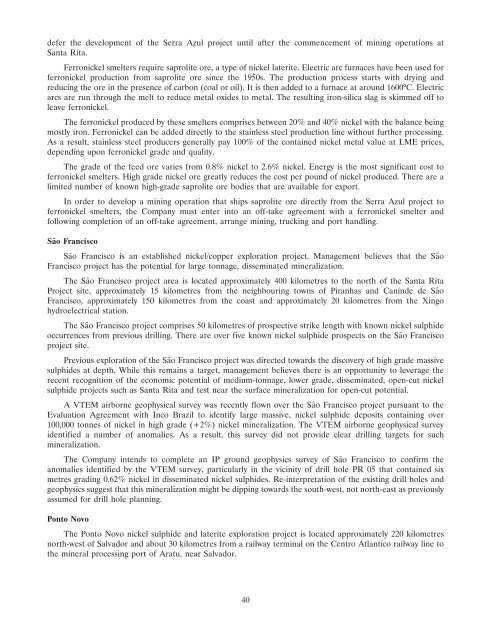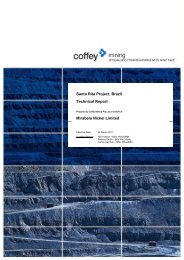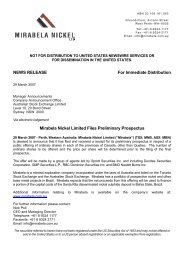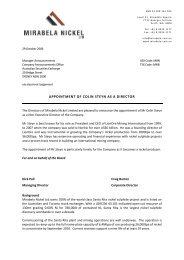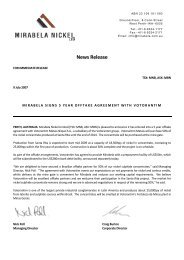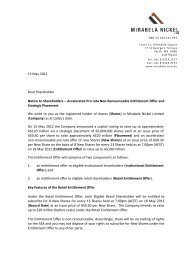COPY OF FINAL PROSPECTUS - Mirabela Nickel
COPY OF FINAL PROSPECTUS - Mirabela Nickel
COPY OF FINAL PROSPECTUS - Mirabela Nickel
Create successful ePaper yourself
Turn your PDF publications into a flip-book with our unique Google optimized e-Paper software.
defer the development of the Serra Azul project until after the commencement of mining operations at<br />
Santa Rita.<br />
Ferronickel smelters require saprolite ore, a type of nickel laterite. Electric arc furnaces have been used for<br />
ferronickel production from saprolite ore since the 1950s. The production process starts with drying and<br />
reducing the ore in the presence of carbon (coal or oil). It is then added to a furnace at around 1600C. Electric<br />
arcs are run through the melt to reduce metal oxides to metal. The resulting iron-silica slag is skimmed off to<br />
leave ferronickel.<br />
The ferronickel produced by these smelters comprises between 20% and 40% nickel with the balance being<br />
mostly iron. Ferronickel can be added directly to the stainless steel production line without further processing.<br />
As a result, stainless steel producers generally pay 100% of the contained nickel metal value at LME prices,<br />
depending upon ferronickel grade and quality.<br />
The grade of the feed ore varies from 0.8% nickel to 2.6% nickel. Energy is the most significant cost to<br />
ferronickel smelters. High grade nickel ore greatly reduces the cost per pound of nickel produced. There are a<br />
limited number of known high-grade saprolite ore bodies that are available for export.<br />
In order to develop a mining operation that ships saprolite ore directly from the Serra Azul project to<br />
ferronickel smelters, the Company must enter into an off-take agreement with a ferronickel smelter and<br />
following completion of an off-take agreement, arrange mining, trucking and port handling.<br />
São Francisco<br />
São Francisco is an established nickel/copper exploration project. Management believes that the São<br />
Francisco project has the potential for large tonnage, disseminated mineralization.<br />
The São Francisco project area is located approximately 400 kilometres to the north of the Santa Rita<br />
Project site, approximately 15 kilometres from the neighbouring towns of Piranhas and Caninde de São<br />
Francisco, approximately 150 kilometres from the coast and approximately 20 kilometres from the Xingo<br />
hydroelectrical station.<br />
The São Francisco project comprises 50 kilometres of prospective strike length with known nickel sulphide<br />
occurrences from previous drilling. There are over five known nickel sulphide prospects on the São Francisco<br />
project site.<br />
Previous exploration of the São Francisco project was directed towards the discovery of high grade massive<br />
sulphides at depth. While this remains a target, management believes there is an opportunity to leverage the<br />
recent recognition of the economic potential of medium-tonnage, lower grade, disseminated, open-cut nickel<br />
sulphide projects such as Santa Rita and test near the surface mineralization for open-cut potential.<br />
A VTEM airborne geophysical survey was recently flown over the São Francisco project pursuant to the<br />
Evaluation Agreement with Inco Brazil to identify large massive, nickel sulphide deposits containing over<br />
100,000 tonnes of nickel in high grade (+2%) nickel mineralization. The VTEM airborne geophysical survey<br />
identified a number of anomalies. As a result, this survey did not provide clear drilling targets for such<br />
mineralization.<br />
The Company intends to complete an IP ground geophysics survey of São Francisco to confirm the<br />
anomalies identified by the VTEM survey, particularly in the vicinity of drill hole PR 05 that contained six<br />
metres grading 0.62% nickel in disseminated nickel sulphides. Re-interpretation of the existing drill holes and<br />
geophysics suggest that this mineralization might be dipping towards the south-west, not north-east as previously<br />
assumed for drill hole planning.<br />
Ponto Novo<br />
The Ponto Novo nickel sulphide and laterite exploration project is located approximately 220 kilometres<br />
north-west of Salvador and about 30 kilometres from a railway terminal on the Centro Atlantico railway line to<br />
the mineral processing port of Aratu, near Salvador.<br />
40


